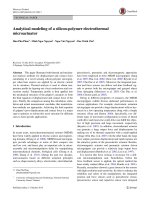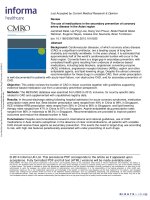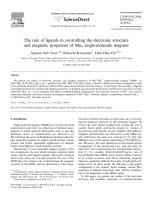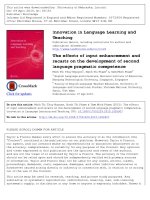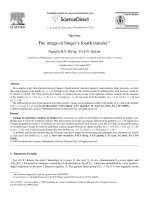DSpace at VNU: The convention of a doctoral thesis in applied linguistics from a European and North American perspective
Bạn đang xem bản rút gọn của tài liệu. Xem và tải ngay bản đầy đủ của tài liệu tại đây (127.44 KB, 8 trang )
VNU Journal of Science, Foreign languages 28 (2012) 82-89
The convention of a doctoral thesis in applied linguistics from
a European and North American perspective
Lê Văn Canh1,*, Roger Barnard2
1
International Co-operation Office, University of Languages and International Studies,
Vietnam National University, Hanoi, Pham Van Dong street, Cau Giay, Hanoi, Vietnam
2
University of Waikato, New Zealand
Received 28 February 2012, Accepted 30 March 2012
Abstract. This article provide guidance on how to write a good PhD thesis in Applied Linguistics
according to the conventions and requirements commonly adopted by European and North
American universities. The purpose of the article is to provide a reference for both PhD candidates
and examiners in Vietnam in an attempt to narrow the gap between Vietnam-based PhD
programmes and those offered by European and North American universities.
Key words: applied linguistics, doctoral thesis, conventional structure, European and North
American conventions.
universities and cultures, but, in general, many
thesis examiners look for the following criteria:
Original work on a relevant topic
Valuable contribution to academic
community
Comprehensive and critical review of
literature
Clearly stated hypotheses or research
questions
Appropriate methodology and data
effectively conducted and analysed
Awareness of ethical issues and
appropriate handling
Clear presentation and explanation of
findings
Fully-informed
discussion/interpretation of findings
Awareness of theoretical implications
of the research
Coherent presentation and appropriate
style
The thesis, or parts of it, is readily
publishable.
1. Introduction
Vietnam is currently making every effort to
participate in the internationalisation of higher
education. One of its great concerns is how to
make its PhD programmes internationally
recognised. In an attempt to make a modest
contribution to that endeavour we, in this
article, provide advice on how to write a good
PhD thesis, according to the common
conventions of European universities, as
guidance to those who are studying for this
degree within Vietnam. Because we are both
from the same academic background, our
presentation may be more relevant to applied
linguistics than to other disciplines.∗
It is certainly the case that the quality of a
PhD thesis (or dissertation) varies across
_______
∗
Corresponding author: Tel: +84-913 563 126
Email:
82
L.V. Canh, Roger Barnard / VNU Journal of Science, Foreign languages 28 (2012) 82-89
Similarly, conceptions of what constitutes a
sound thesis may differ. So may the
organisational structure of the thesis. DudleyEvans (1999) [1] and Thompson (1999) [2] and
Dong (1998) [3] examined a number of thesis
types from different academic disciplines.
Dudley-Evans described the structure of a
“traditional” thesis as being composed of
Introduction-Methods-ResultsDiscussion
(IMRAD). Thompson refined this category
further by dividing ‘traditional’ theses into
those with ‘simple’ and those with ‘complex’
patterns of organization. A further type of thesis
is labelled as ‘topic-based theses. This type of
thesis
typically
commences
with
an
introductory chapter which is then followed by
a series of chapters which have titles based on
subtopics of the topic under investigation. The
thesis then ends with a conclusion chapter.
However, as Johns and Swales (2002) [4] have
pointed, even the basic outline of a thesis is a
complex issue that needs to be negotiated
among supervisors and students. Therefore,
sub-fields, methodology, and choice of an
appropriate theoretical framework will all
emerge as strong determining factors in terms
of what a thesis might look like.
2. The Conventional Structure of the Thesis
For the purpose of this short article, we will
suggest that a thesis is a sustained academic
argument which is made as a result of having
undertaken original empirical research. It
usually comprises:
Abstract.
List
of
contents.
Acknowledgements
1. Introduction (setting the problem in
context)
2. Literature review (current, crucial
and critical)
83
3. Methodology: Justification of
theoretical perspective, methods &
procedures for data collection and
analysis
4. Findings: Presentation of, and
commentary on, what the study has
found
5. Discussion: Interpretation of the
findings in relation to other studies in
the field
6. Conclusion: Implications for theory,
further research, and practice
References and Appendices
Taking these points into account, we will
now explain what we consider to be the
purposes and major elements of each chapter of
a thesis.
Abstract
While not itself a chapter of the thesis, it is
the first thing that academics read when they
are asked if they would wish to examine the
thesis. Therefore, it should be a short (about
500 words) and accurate summary of the aims,
purposes, methods and major findings of the
thesis. The significance of the study and the
implications it has for the academic community
should be concisely stated. (Obviously, this is
almost the last thing that you will write after
completing your study, although you will write
drafts as your study progresses.)
Introduction
The main purpose of this chapter is to
explain, briefly, the aims and significance of
your study, the ‘problem’ that you wish to
explore, how you intend to carry out the
investigation, and the context in which the
investigation takes place. It is also important,
especially in qualitative studies, to explain the
researcher’s own position and motivation for
doing the study. Opinions vary as to the style
in which this introduction should be written: on
the whole, introductions to quantitative studies
84
L.V. Canh, Roger Barnard / VNU Journal of Science, Foreign languages 28 (2012) 82-89
tend to be written impersonally, using mostly
the passive voice; qualitative studies, on the
other hand, tend to put the researcher’s ‘voice’
very much at the forefront, acknowledging that
the researcher is also a participant in the study,
not merely a neutral, impartial reporter of
objective data. The introduction sets the tone
for the entire thesis, and like all following
chapters, must be coherent in organising the
ideas and accurately written. (This chapter is
probably the last one that will be written, before
the final abstract.)
Literature review
The review of literature, so central to
scholarly work and disciplined inquiry, is
expected of the doctoral student. Examiners
tend to view ‘working understanding’, ‘critical
appraisal’ of the body of literature, ‘connection
of the literature to findings’ and ‘disciplinary
perspective’ as key indicators of performance in
the PhD candidate’s literature review. Three
categories of examiner comments on the
literature review are literature coverage,
inaccuracies and use and application (Holbrook,
et al., 2007) [5] and the two “most common
criticisms” made by examiners are the “failure
to use recent literature and the inability to
critically assess the existing literature”
(Hanford & Maxwell, 1993) [6: 179]. The aim
of the literature review is to demonstrate that
you are fully aware of what has been published
about the topic you are investigating, so that
you can conclude the review by identifying the
‘research space’ that your thesis intends to
occupy (Machi & McEvoy, 2009 [7]; Ridley,
2008) [8]. The review should be of current
literature – books and refereed journal articles
published within the past ten years, although
some earlier, seminal works on the topic may
be referred to. You should not simply display
your knowledge of the works, but should
academically engage with them – for example,
by carefully comparing and contrasting the
views and findings of one author or research
report with those of others, and by critiquing
(i.e., weighing the positive and negative points)
and evaluating the studies. You should also
make it clear why these particular works are
relevant to your thesis. By the end of your
review, you will be able to state the gap in
previous studies that you intend to fill by your
investigation, and this statement should then
lead to your formulation of the key research
questions or hypotheses that will guide your
study. Like all the other chapters in the thesis,
the literature review will undergo several drafts,
especially in conjunction with the Discussion
chapter, as will be explained below.
Methodology
The aim of this chapter is to justify the
methodological approach you have chosen and
to explain very clearly the methods of data
collection and analysis that you will have
adopted
to
address
your
research
questions/hypotheses. The first part of the
chapter, then, will be a reasoned argument as to
why you have chosen a qualitative or
quantitative paradigm within which to work;
this will involve referring to standard works in
research methodology, such as Cohen, Manion
and Morrison (2007) [9], or Merriam (1998)
[10]. This will be followed by a discussion of
the particular ways of collecting data that will
inform your study – for example, experiment
(or quasi-experiment), questionnaire, interview,
observation, etc – and why these are relevant;
again, reference to standard works which
discuss these particular methods will be
necessary. (Two very useful books to start your
thinking about this are Heigham & Croker,
2009 [11] and Richards, 2003) [12]. It is also
important at this point to critique the
L.V. Canh, Roger Barnard / VNU Journal of Science, Foreign languages 28 (2012) 82-89
methodological approaches used in the
empirical studies you have referred to in your
literature review (where, you will have focussed
on the findings, rather than the methodology, of
these studies). Having thus justified your
methodological paradigm and data collection
methods, the second part of the chapter will
explain the contextual details and the actual
procedures you have used. Thus, you will
describe the specific setting of your study, the
actual research participants, and the logistical
and ethical procedures you adopted to recruit
them and to obtain their informed consent to
participate in your study. This will be followed
by details about how you actually obtained the
data: the items in the questionnaire, and how it
was administered (by hand, online, by email.,
etc); the length and frequency of individual
interviews and the focus points of those
interviews, the number of times you observed
lessons and the criteria you applied to these
observations, etc.
You also need to explain what procedures
you adopted for piloting your research methods,
and the revisions that you made following this
piloting. It is also important that you explain in
some detail the ways in which the data you
have collected were analysed. The chapter will
conclude with a summary of the key points and
a brief preview of the following chapter.
Results/Findings
The purpose of this chapter is to clearly
present and explain what you have found from
your research instruments. If you have adopted
a quantitative approach, your results will be
presented in various tables, and each table will
be followed by a clear explanation of what the
statistical data implies. Most quantitative
doctoral theses will use inferential statistics to
identify
cause-and-effect
relationships
85
(experiment) or probability (non-causal)
correlations between the key variables you have
identified in the Methodology chapter. Thus, a
very important point is to explain why you have
chosen to apply specific statistical tests (chisquare, ANOVA, etc.) to validate these
relationships. In quantitative research, all the
data you have collected must be displayed and
explained, otherwise the results will be
considered unreliable. This is not the case in
qualitative research – because the vast amount
of data you have collected cannot be put into
tabulated or statistical form, or indeed
completely reported in full. Rather, you need to
select key findings from the various ways you
have collected your data and explain the
significance of these within the context of your
study. You may decide to present your findings
in the chronological order of the data collection
methods you used (e.g., interview, observation,
stimulated recall) or else in terms of the key
themes that have arisen from your analysis of
the data. The very fact that you have to make
such decisions clearly indicates that your
interpretation of the findings is inherently
subjective. This does not invalidate your
interpretation, but you need to support your
commentary with a wealth of quotations (e.g.,
from interviews) or extracts from transcript data
(e.g. from lesson observations); you should also
include findings that do not support your
general point of view; doing so will assist the
reader/examiner to trust your interpretations.
Again, at the end of this chapter, you should
summarise the key findings, and point forward
to the next chapter.
Discussion
The purpose of this chapter is to relate your
results/findings to those reported in previous
published work. Here, it is essential to refer
back to the studies reported in your Literature
86
L.V. Canh, Roger Barnard / VNU Journal of Science, Foreign languages 28 (2012) 82-89
Review, to compare and contrast what you have
uncovered with what other researchers have
found. It will almost certainly be necessary, at
this stage, to revise your Literature Review.
This is for two reasons; firstly, new studies may
have been published since your original draft;
secondly, and more importantly, it is likely that
you will have discovered some important points
that you did not think about when originally
drafting Chapter 2. The Discussion chapter is
often considered the most important in the
thesis, and many examiners begin their
consideration by reading this chapter first. This
is because it is here that you show the quality of
your interpretation and intellectual argument,
thus justifying your position to join the
international community of scholars.
Conclusion
The purpose of this chapter is to show that
you can present the implications of your study
based on the position you have taken in the
Discussion chapter. (‘Thesis’ is derived from
the Greek word for position.) It is useful to
summarise the key points made in the previous
chapter, and then to acknowledge the
(inevitable) limitations of your study, in this
way recognising that while you have possibly
found some solutions to the ‘problem’ you have
explored, you have also raised other, important
questions that need to be addressed. Having
done this, you can then, justifiably, explain the
key implications of your work in terms of its
theoretical contribution, further research that is
needed, and how it might influence policy
and/or practice. Your thesis must make an
original
contribution
to
theoretical
understanding of the topic you have
investigated, so you need to explain how your
study has expanded, refined or (unlikely)
rejected a particular theory or theoretical
framework. Next, having previously outlined
the limitations of your own study, you need to
discuss in what ways more research could
further enlighten the academic community;
these suggestions should be specific, outlining
both the range of topics and sub-topics that
could be investigated and the methods by which
such studies might be conducted. Thirdly, you
should discuss how your study is a useful
contribution to (language) policies and
(pedagogical) practice; for example as to
whether a national or institutional policy might
need to be adapted, or how your thesis might
impact upon classroom practice and/or the
professional development of teachers. You
should end the thesis with a bold, but accurate,
statement of the importance of your thesis in
these respects.
References
Evidently, your thesis should be fully
supported by essential background reading;
most theses list 200 or more books, refereed
journal articles, and attested online references.
It is essential that all the published works you
have cited in your chapters are entered in a list
of references after the conclusion – and that this
list does not include works that you have not
referred to. It is also vital that the list should
accurately contain all the relevant publication
details of the works, presented (in alphabetical
order) and fully consistent with one or other
reference manual. (The most common of these
manuals for TESOL and Applied Linguistics is
regularly issued and updated by the APA – the
American Psychological Association. The
suggestions for further reading below are listed
according the APA format.) Similarly, all the
in–text references throughout the thesis should
scrupulously follow the guidelines.
Appendices
L.V. Canh, Roger Barnard / VNU Journal of Science, Foreign languages 28 (2012) 82-89
Most theses have several (or many!)
appendices. These are intended to provide more
detailed information that has not been included
in the body of the thesis, because to do so
would clutter the main ideas and data that are
presented in the various chapters. Each
appendix should be numbered according to the
chapter number and listed as a,b,c, etc. Thus,
for example, the appendices to the
Methodology chapter might, for example,
include:
Appendix 3a. Copies of the letter of
information about the research project and the
consent form signed by the participants
Appendix 3b. Example of an interview
transcript and summary sent to the interviewee
for participant validation
Appendix 3c. Example
observation transcript.
of
a
lesson
Etc.
3. Drafting and redrafting a thesis
It needs to be emphasised that writing a
thesis is not something to be left until after you
have collected and analysed your data. It is an
ongoing process, from the time that you submit
an initial research proposal to the moment
before you submit the final version of the thesis
for examination. Mention has been made of the
need to revise the Literature Review after you
have drafted your Findings chapter and are
working on writing up the Discussion of these
findings. Your Methodology chapter will be
drafted before you actually collect and analyse
your data, and will need to be carefully
revisited afterwards to discuss what you
actually did in your fieldwork. (Like lesson
plans, research schedules never go precisely
according to intentions!). So, your supervisors
87
will want to read and comment on your draft
chapters as you progress through your project.
Even when all the chapters have been drafted
and redrafted, most PhD students say that they
still need several weeks (or months!) to polish
the thesis to their own satisfaction, that of the
supervisors, and that of the examiners.
4. Conclusion
The skills and understandings required for
disciplined scholarly inquiry are acquired
through undertaking research in a defined field
or fields, usually through a research degree such
as a PhD. The journey towards completion of a
doctoral thesis is a long, painstaking and
usually very lonely one - even with expert
advice from very sympathetic supervisors and
solid support from friends and family.
However, the rewards are substantial – and not
only in terms of the eventual title of ‘Doctor’.
During the journey you will learn a great deal
about the topic you are investigating and how to
diligently collect and analyse data. You will
also learn how to construct and write a coherent
and persuasive argument over between 75,000
and 100,000 words (The requirement may be
different by Vietnamese universities). Perhaps
more importantly, you will have tested your
academic skills, your physical and mental
stamina, and your intellectual rigour and
honesty – and you will certainly emerge not
only better-informed but wiser, and an
acknowledged member of the international
community of scholars. It is critical to note that
the qualities of “meticulousness and rigour
associated with academic inquiry and
reporting” (Brew, 2001) [13:45] are not easily
attained or accessed, and they require time and
88
L.V. Canh, Roger Barnard / VNU Journal of Science, Foreign languages 28 (2012) 82-89
immersion in research activity to form and
develop.
As stated in the Introduction, our purpose in
writing this article is to provide a reference for
the PhD candidates who are completing their
thesis in Vietnamese universities. Although the
article is largely based on the common
conventions and requirements of Australian and
New Zealand universities, we believe that these
are also common in many European and North
American universities. The conventions and
requirements by Vietnamese universities may
be quite different, and our aim is to make a
modest contribution to the attempt to make
Vietnamese PhDs internationally recognized.
Given the gap between Vietnamese universities
and European and North American universities
regarding these conventions and requirements,
candidates are advised to consult their
supervisors who “will be more able than their
students to see what variations are conventional
in their particular field” (Bunton, 2002) [14]
and in their university.
References
[1] Dudley-Evans, T., The dissertation: A case of
neglect? In P. Thompson (Ed.), Issues in EAP
writing research and instruction (pp.28-36),
Reading: Centre for Applied Language Studies,
University of Reading, 1999.
[2] Thompson, P., Exploring the context of writing:
Interviews with PhD supervisors. In P.
Thompson (Ed.), Issues in EAP writing research
and instruction (pp.37-54), Reading: Centre for
Applied Language Studies, University of
Reading, 1999.
[3] Dong, Y. R., Non-native graduate students’
thesis/dissertation writing in science: Selfreports by students and their advisors from two
U.S. institutions, English for specific Purposes,
17(4), 369-390, 1998.
[4] John, A. M., & Swales, J. M., Literacy and
disciplinary practices: Opening and closing
perspectives, Journal of English for Academic
Purposes, 1(1), 13-28, 2002.
[5] Holbrook, A., Bourke, S., Fairbairn, & Lovat, T.,
Examiner comment on the literature review in
Ph.D. theses, Studies in Higher Education,
32(3), 337-356, 2007.
[6] Hansford, B. C., & Maxwell, T. W., A Masters
degree program: Structural components and
examiners’ comments, Higher Education
Research and Development, 12(2), 171-187,
1993.
[7] Machi, L. A., & McEvoy, B. T., The literature
review: Six steps to success, California: Corwin
Press, 2009.
[8] Ridley, D., The literature review: A step-by-step
guide for students, London, England: SAGE
Publications, 2008.
[9] Cohen, L., Manion, L. & Morrison, K.,
Research methods in education.
(6th ed.).
London, England: Routledge, 2007.
[10] Merriam, S. B., Qualitative research and case
study applications in education: Revised and
expanded from case study research in education,
Sacramento, CA: Jossey-Bass, 1998.
[11] Heigham, J., & Croker, R. A. (Eds.), Qualitative
research in applied linguistics: A practical
introduction, Basingstoke, England: Palgrave
Macmillan, 2009.
[12] Richards, K., Qualitative inquiry in TESOL,
Basingstoke, England: Palgrave MacMillan,
2003.
[13] Brew, A., The nature of research: Inquiry in
academic contexts, London: Routledge Falmer,
2001.
[14] Bunton, D., Generic moves in PhD theses
introductions, In J. Flowerdew (Ed.), Academic
discourse, Harlow: Longman, 57-75, 2002.
Some useful books
Anderson, J., & Poole, M., Thesis and
assignment writing, Brisbane, Australia: Wiley
& Sons, 1994.
Bitchener, J., Writing an applied linguistics
thesis or dissertation: A guide to presenting
empirical research. Basingstoke, England:
Palgrave MacMillan, 2010.
L.V. Canh, Roger Barnard / VNU Journal of Science, Foreign languages 28 (2012) 82-89
Bell, J., Doing your research project,
Milton Keynes, England: Open University
Press, 1987.
Bowen, W.G., In pursuit of the PhD,
Princeton, N.J.: Princeton University Press,
1992.
Brause, R.S., Writing your doctoral
dissertation: Invisible rules for success,
London, England: Falmer Press, 2000.
Graves, N. & Varma, V. (Eds.), Working
for a doctorate, London, England: Routledge,
1997.
89
Oliver, P., Writing your thesis, London,
England: Sage, 2004.
Swales, J. M., Genre analysis: English in
academic and research settings, Cambridge,
England: Cambridge University Press, 1990.
Swales, J. M., Research genres:
Exploration and application, Cambridge,
England: Cambridge University Press, 2004.
Turabian, K. L., Grossman, J., & Bennett,
A., A manual for writers of term papers, theses
and dissertations, Chicago, ILL: Chicago
University Press, 1996.
Yêu cầu đối với luận án tiến sĩ chuyên ngành ngôn ngữ học
ứng dụng theo quy ước châu Âu và Bắc Mỹ
Lê Văn Canh1, Roger Barnard2
1
Phòng Hợp tác Quốc tế, Trường Đại học Ngoại ngữ,
Đại học Quốc gia Hà Nội, Đường Phạm Văn Đồng, Cầu Giấy, Hà Nội, Việt Nam
2
Đại học Waikato, New Zealand
Bài viết cung cấp những chỉ dẫn về cách viết một luận án tiến sĩ chuyên ngành ngôn ngữ học ứng
dụng theo những quy ước phổ biến của các trường Châu Âu và Bắc Mỹ. Mục đích của bài viết là cung
cấp những thông tin để các nghiên cứu sinh và các thành viên trong hội đồng chấm luận án tiến sĩ
tham khảo với hy vọng là giúp thu hẹp khoảng cách trong việc đào tạo tiến sĩ (chuyên ngành ngôn ngữ
học ứng dụng) của Việt Nam với các trường châu Âu và Bắc Mỹ.
Từ khóa: ngôn ngữ học ứng dụng, luận án tiến sĩ, cấu trúc quy ước, quy ước châu Âu và Bắc Mỹ.



